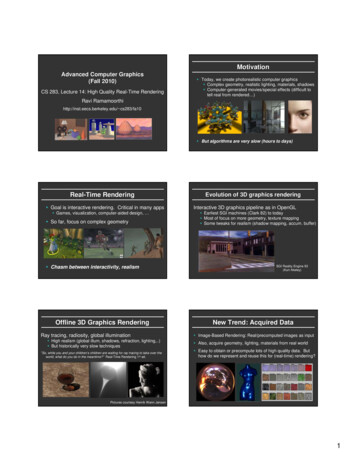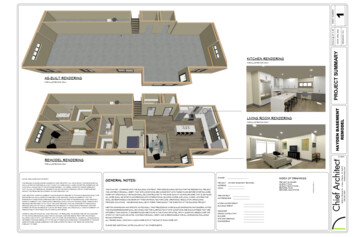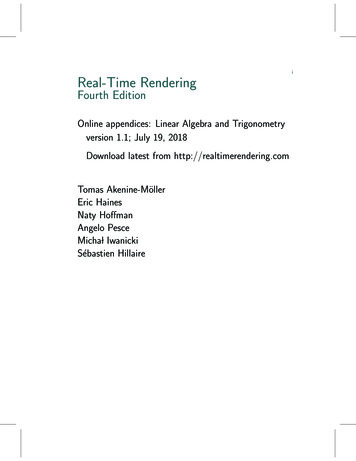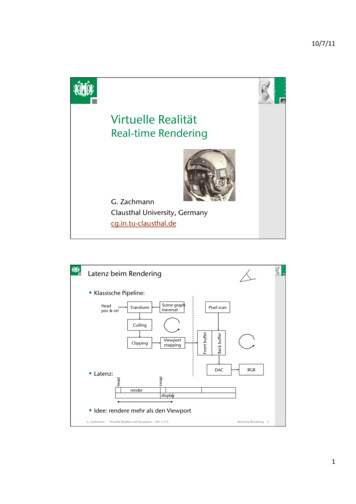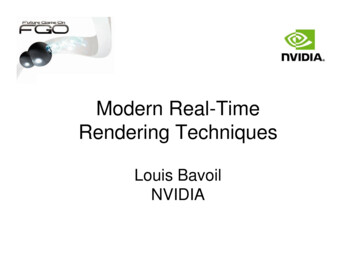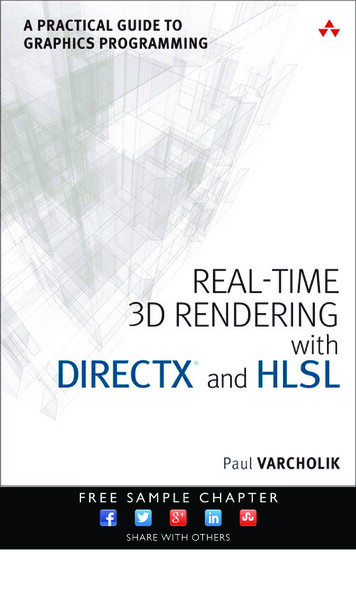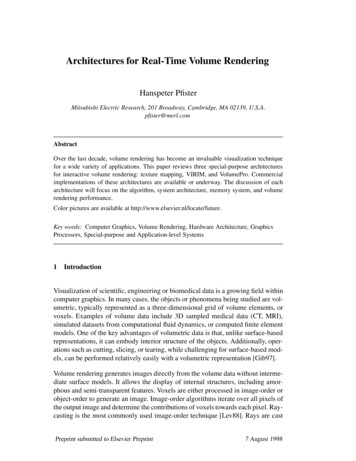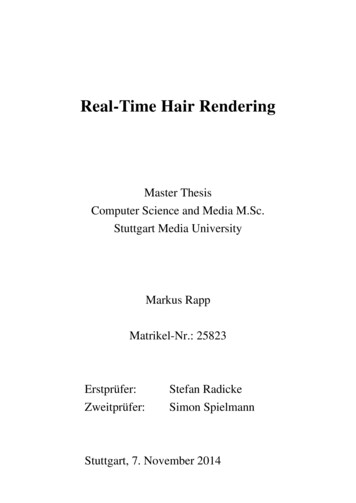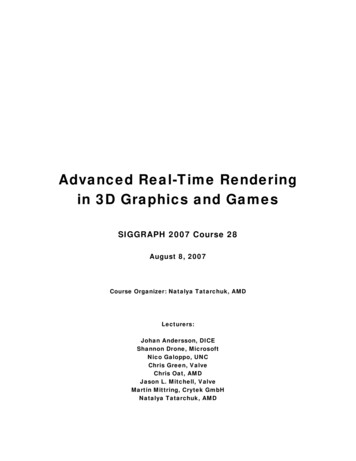
Transcription
Advanced Real-Time Renderingin 3D Graphics and GamesSIGGRAPH 2007 Course 28August 8, 2007Course Organizer: Natalya Tatarchuk, AMDLecturers:Johan Andersson, DICEShannon Drone, MicrosoftNico Galoppo, UNCChris Green, ValveChris Oat, AMDJason L. Mitchell, ValveMartin Mittring, Crytek GmbHNatalya Tatarchuk, AMD
Advanced Real-Time Rendering in 3D Graphics and Games – SIGGRAPH 2007About This CourseAdvances in real-time graphics research and the increasing power of mainstream GPUshas generated an explosion of innovative algorithms suitable for rendering complexvirtual worlds at interactive rates. This course will focus on the interchange of ideas fromgame development and graphics research, demonstrating converging algorithmsenabling unprecedented visual quality in real-time. This course will focus on recentinnovations in real-time rendering algorithms used in shipping commercial games andhigh end graphics demos. Many of these techniques are derived from academic workwhich has been presented at SIGGRAPH in the past and we seek to give back to theSIGGRAPH community by sharing what we have learned while deploying advancedreal-time rendering techniques into the mainstream marketplace.This course was introduced to SIGGRAPH community last year and it was extremelywell received. Our lecturers have presented a number of innovative renderingtechniques – and you will be able to find many of those techniques shine in theupcoming state-of-the-art games shipping this year, and even see the previews of thosegames in this year’s Electronic Theater.This year we will bring an entirely new set of techniques to the table, and even more ofthem are coming directly from the game development community, along with industryand academia presenters. The second year version of this course will include state-ofthe-art real-time rendering research as well as algorithms implemented in several awardwinning games and will focus on general, optimized methods applicable in variety ofapplications including scientific visualization, offline and cinematic rendering, and gamerendering. Some of the topics covered will include rendering face wrinkles in real-time;surface detail maps with soft self-shadowing and fast vector texture maps rendering inValve’s SourceTM engine; interactive illustrative rendering in Valve’s Team Fortress 2.This installation of the course will cover terrain rendering and shader network design inthe latest Frostbite rendering engine from DICE, and the architectural design andframework for direct and indirect illumination from the upcoming CryEngine 2.0 byCrytek. We will also introduce the idea of using GPU for direct computation of non-rigidbody deformations at interactive rates, along as with advanced particle dynamics usingDirectX10 API.We will provide an updated version of these course notes with more materials aboutreal-time tessellation and noise computation on GPU in real-time, downloadable fromACM Digital Library and from AMD ATI developer website prior to SIGGRAPH.PrerequisitesThis course is intended for graphics researchers, game developers and technicaldirectors. Thorough knowledge of 3D image synthesis, computer graphics illuminationmodels, the DirectX and OpenGL API Interface and high level shading languages andC/C programming are assumed.ii
TopicsExamples of practical real-time solutions to complex rendering problems: Terrain rendering with procedural texture splattingReal-time tessellation and noise generation on GPUArchitectural design and illumination techniques from CryEngine 2.0Facial wrinkles rendering and animationReal-time particle systems on the GPU in dynamic environmentsGPU-accelerated simulation of deformable models in contactEfficient self-shadowed radiosity normal mappingImproved alpha-tested magnification for vector textures and special effectsIllustrative rendering in Team Fortress 2Suggested Reading Real-Time Rendering by Tomas Akenine-Möller, Eric Haines, A.K. Peters, Ltd.; 2nd edition, 2002Advanced Global Illumination by Philip Dutre, Phillip Bekaert, Kavita Bala, A.K. Peters, Ltd.; 1stedition, 2003Radiosity and Global Illumination by François X. Sillion, Claude Puech; Morgan Kaufmann, 1994.Physically Based Rendering : From Theory to Implementation by Matt Pharr, Greg Humphreys;Morgan Kaufmann; Book and CD-ROM edition (August 4, 2004)The RenderMan Companion: A Programmer's Guide to Realistic Computer Graphics, Steve Upstill,Addison Wesley, 1990.Advanced RenderMan: Creating CGI for Motion Pictures, Tony Apodaca & Larry Gritz, MorganKaufman 1999.Texturing and Modeling, A Procedural Approach Second Edition, Ebert, Musgrave, Peachey,Perlin, Worley, Academic Press Professional, 1998.ShaderX5: Advanced Rendering Techniques, by Wolfgang Engel (Editor), Charles River Media, 1stedition (December 2006)ShaderX4: Advanced Rendering Techniques, by Wolfgang Engel (Editor), Charles River Media, 1stedition (November 2005)ShaderX3: Advanced Rendering with DirectX and OpenGL, by Wolfgang Engel (Editor), CharlesRiver Media, 1st edition (November 2004)ShaderX2: Introductions and Tutorials with DirectX 9.0, by Wolfgang Engel (Editor), WordwarePublishing, Inc.; Book and CD-ROM edition (November 2003)ShaderX2 : Shader Programming Tips and Tricks with DirectX 9.0, by Wolfgang Engel (Editor),Wordware Publishing, Inc.; Book and CD-ROM edition (November 2003)iii
Advanced Real-Time Rendering in 3D Graphics and Games – SIGGRAPH 2007LecturersNatalya Tatarchuk is a staff research engineer leading the research team in AMD's 3DApplication Research Group, where pushes the GPU boundaries investigating innovativegraphics techniques and creating striking interactive renderings leading the research team. In thepast she led the creation of the state-of-the-art realistic rendering of city environments in ATIdemo “ToyShop” and has been the lead for the tools group at ATI Research. Natalya has been inthe graphics industry for years, having previously worked on haptic 3D modeling software,scientific visualization libraries, among others. She has published multiple papers in variouscomputer graphics conference and articles in technical book series such as ShaderX and GameProgramming Gems, and has presented talks at Siggraph and at Game Developers Conferencesworldwide, amongst others. Natalya holds BAs in Computers Science and Mathematics fromBoston University.Chris Oat is a staff engineer in AMD's 3D Application Research Group where he is the technicallead for the group's demo team. In this role, he focuses on the development of cutting-edgerendering techniques for leading edge graphics platforms. Christopher has published severalarticles in the ShaderX and Game Programming Gems series and has presented his work atgraphics and game developer conferences around the world.Jason L. Mitchell is a software developer at Valve, where he works on real-time graphicstechniques for all of Valve's projects. Prior to joining Valve in 2005, Jason worked at ATI for 8years, where he led the 3D Application Research Group. He received a BS in ComputerEngineering from Case Western Reserve University and an MS in Electrical Engineering from theUniversity of Cincinnati.Chris Green is a software engineer at Valve, and has working on the Half-Life 2 series and Dayof Defeat. Prior to joining Valve, Chris Green worked on such projects as Flight Simulator II,Ultima Underworld, the Amiga OS, and Magic:The Gathering Online. He ran his owndevelopment studio, Leaping Lizard Software, for 9 years.Johan Andersson is a self-taught senior software engineer/architect in the central technologygroup at DICE. For the past 7 years he has been working on the rendering and core enginesystems for games in the RalliSport and Battlefield series. He now drives the rendering side ofthe new Frostbite engine for the pilot game Battlefield: Bad Company (Xbox 360, PS3). Recentcontributions include a talk at GDC about graph-based procedural shading.Martin Mittring is a software engineer and member of the R&D staff at Crytek. Martin startedhis first experiments early with text-based computers, which led to a passion for computer andgraphics in particular. He studied computer science and worked in one other German gamescompany before he joined Crytek. During the development of Far Cry he was working onimproving the PolybumpTM tools and was became lead network programmer for that game. Hispassion for graphics brought him back to former path and so he became lead graphicsprogrammer in R&D. Currently he is busy working on the next iteration of the engine to keeppushing future PC and next-gen console technology.Nico Galoppo is currently a PhD. student in the GAMMA research group at the UNC ComputerScience Department, where his research is mainly related to physically based animation andsimulation of rigid, quasi-rigid and deformable objects, adaptive dynamics of articulated bodies,hair rendering, and many other computer graphics related topics. He also has experience withaccelerated numerical algorithms on graphics processors, such as matrix decomposition. Hisadvisor is Prof. Ming C. Lin and he is also in close collaboration with Dr. Miguel A. Otaduyiv
(ETHZ). Nico has published several peer-reviewed papers in various ACM conferenceproceedings had he has presented his work at the SIGGRAPH and ACM Symposium ofComputer Animation conferences. Nico grew up in Belgium and holds an MSc in ElectricalEngineering from the Katholieke Universiteit Leuven.Shanon Drone is a software developer at Microsoft. Shanon joined Microsoft in 2001 and hasrecently been working on Direct3D 10 samples and applications. He spends a great deal of histime researching and implementing new and novel graphics techniques.v
Advanced Real-Time Rendering in 3D Graphics and Games – SIGGRAPH 2007Contents1 GreenEfficient Self-Shadowed Radiosity Normal Mapping12GreenImproved Alpha-Tested Magnification for Vector Textures and Special Effects 93MitchellIllustrative Rendering in Team Fortress 219OatAnimated Wrinkle Maps33AnderssonTerrain Rendering in Frostbite using Procedural Shader Splatting38GaloppoDynamic Deformation Textures59DroneReal-Time Particle Systems on the GPU in Dynamic Environments80MittringFinding Next Gen - CryEngine297456789TatarchukReal-Time Isosurface Extraction Using the GPU Programmable GeometryPipelinevi122
PrefaceWelcome to the Advanced Real-Time Rendering in 3D Graphics and Games course atSIGGRAPH 2007. We’ve included both 3D Graphics and Games in our course title inorder to emphasize the incredible relationship that is quickly growing between thegraphics research and the game development communities. Although in the pastinteractive rendering was synonymous with gross approximations and assumptions,often resulting in simplistic visual rendering, with the amazing evolution of the processingpower of consumer-grade GPUs, the gap between offline and real-time rendering israpidly shrinking. Real-time domain is now at the forefront of state-of-the-art graphicsresearch – and who wouldn’t want the pleasure of instant visual feedback?As researchers, we focus on pushing the boundaries with innovative computer graphicstheories and algorithms. As game developers, we bend the existing software APIs suchas DirectX and OpenGL and the available hardware to perform our whims at highlyinteractive rates. And as graphics enthusiasts we all strive to produce stunning imageswhich can change in a blink of an eye and let us interact with them. It is this synergybetween researchers and game developers that is driving the frontiers of interactiverendering to create truly rich, immersive environments. There is no greater satisfactionfor developers than to share the lessons learned and to see our technologies used inways never imagined.This is the second time this course is presented at SIGGRAPH and we hope that youenjoy the new material presented this year and come away with a new understanding ofwhat is possible without sacrificing interactivity! We hope that we will inspire you to drivethe real-time rendering research and games!Natalya Tatarchuk, AMDApril, 2007vii
Advanced Real-Time Rendering in 3D Graphics and Games Course – SIGGRAPH 2007Chapter 1Efficient Self-ShadowedRadiosity Normal MappingChris Green1Normal MappedNormal mapped with ambientocclusionFigure 1. Comparison of surface illumination techniques.1.1Self-shadowedAbstractIn Valve’s Source graphics engine, bump mapping is combined with precomputedradiosity lighting to provide realistic surface illumination. When bump map data isderived from geometric descriptions of surface detail (such as height maps), only thelighting effects caused by the surface orientation are preserved. The significant lightingcues due to lighting occlusion by surface details are lost. While it is common to useanother texture channel to hold an “ambient occlusion” field, this only provides adarkening effect which is independent of the direction from which the surface is being litand requires an auxiliary channel of data.In this chapter, we present a modification to the Radiosity Normal Mapping system thatwe have described in this course in the past. This modification provides a directionalocclusion function to the bump maps, which requires no additional texture memory andis faster than our previous non-shadowing solution.1email: cgreen@valvesoftware.com1
Chapter 1: Efficient Self-Shadowed Radiosity Normal Mapping1.2IntroductionIn order to increase surface detail and perceived realism, bump mapping is used heavilyin modern real-time 3D games [Blinn78] [PAC97]. Bump maps are often used as anapproximation of higher detailed geometry which would either be to slow to render in realtime or too memory intensive to store reasonably. However, one weakness of bumpmaps is that they only modify the surface normal which is used for lighting computations.While this provides a realistic directional lighting cue, effects such as self-shadowing ofsurface details and ambient occlusion are n
the latest Frostbite rendering engine from DICE, and the architectural design and framework for direct and indirect illumination from the upcoming CryEngine 2.0 by Crytek. We will also introduce the idea of using GPU for direct computation of non-rigid body deformations at interactive rates, along as with advanced particle dynamics using
